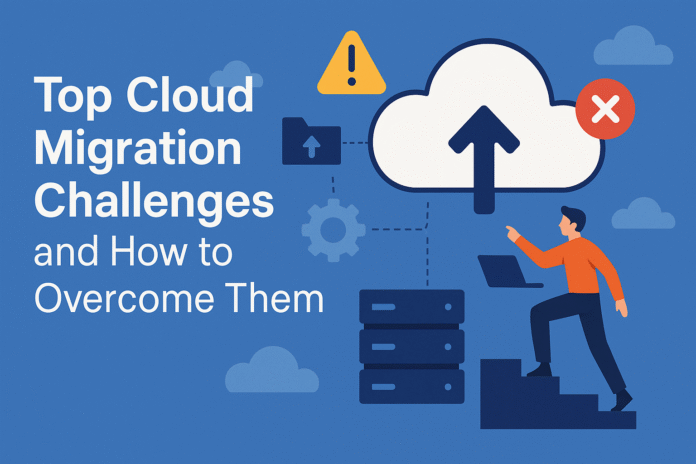Moving to the cloud remains as a driver of strategic digital transformation- the key to scalability, agility, innovation, and long-term efficiency. In the Flexera 2024 State of the Cloud report, 84 percent of organizations said managing cloud costs was their greatest challenge, even ahead of threats posed by cybersecurity issues. Also, Forbes points out that cloud strategies are being reviewed by organizations based on the budget overruns and inadequate operational efficiency.
This gives away one of the major realities: cloud migration strategy is not only an exercise in technical application, it has to be supported by a strategic direction and with financial controls. Migration without a detailed plan is an inadvisable decision in the current business environment where other factors such as nimbleness and cost predictability cannot be ignored.
An article on Forbes brought forth the new found tone: It is not who can migrate quickest. It is who can migrate the smartest. This is more essential because enterprises are using legacy systems, and following regulations that are becoming strict day by day. Multi-cloud complexity is increasingly responsible to provide ROI back to the cloud investments.
This guide examines the most common obstacles that enterprises face when considering cloud migration, including talent shortage and outdated application reliance, cost spiral, and the so-called vendor lock-in, and, most importantly, provides practical and actionable solutions to these problems. Whether you migrate a few services or replace your entire IT backbone, these lessons will keep you strategic, effective and resilient on your cloud roadmap.
Why Migration Often Fails Without a Strategy?
Most organisations consider cloud migration as a tactical Information Technology exercise in place of strategic initiative. Such an attitude results in poor communication, requirements that are not complete, underestimation of costs, and vendor lock-in. A cloud strategy should verify migration as business objectives such as cost optimization, platform agility, and global scale. Businesses that pretest the preparedness and supplement the aim of transformation considerably enhance results and ROI.
- Strategy Misalignment: Where there is a Divergence Between Vision and Execution
When a cloud migration does not include a strategic vision, it will have become a collection of technical lift-and-shift work. Migration groups act following unguided directions thus leading to technical debt and inefficiency in operations. The organizations need to set the purpose of transferring workload to the cloud, what success means, and what schedules and platforms are achievable. When outsourcing cloud consulting services is implemented in the process of strategy development, it guarantees that architecture and execution are driven by business needs and not the other way around.
2. Proficiency Deficiencies and Talent-mismatches
As part of underestimation of many of the teams, the technical and operational maturity required to maintain cloud deployment is also underestimated. Cloud-native environments come with novel toolchain Cloud-native systems present new toolchain-CI/CD pipelines, container orchestration, such as Kubernetes, Terraform automation, and DevOps workflows. The absence of such capabilities may slow down projects, and make them expensive. This gap is closed by involving cloud consulting partners or by means of structured training, which accomplishes migration faster and safely.
3. Legacy Apps do not Migrate well
Not every legacy system can be used with cloud apps. Tightly-coupled apps, which are connected closely to on-premise frameworks, with obsolete licensing or backend dependencies, are particularly challengingly troubling. Instead of any single line of migration, organizations work better when in a phased strategy: refactor services with high utilization, upgrade the old monoliths with SaaS or modular microservices, and create hybrid load where necessary. This maintains availability and modernizes the most significant layers of software.
5. Surprising Performance Bottlenecks
Users will demand that their applications perform seamlessly, and this ultimately presents a problem because poorly executed capacity planning or design of the network may result in delays or failure after migration. Processing intensive tasks may require an edge computing environment or low-latency connections, including real-time analytics or image processing. To prevent surprises, it is necessary to benchmark the existing infrastructure, put in place service level agreements, and plan auto-scaling clusters, with content delivery networks or edge nodes.
6. Billing surprises and Cost overruns
Unpredictable costs unchecked by monitoring are common in hyperscales often with data egress, storage tiering, high-CPU instances. Cost management, rightsizing, and tagging are necessary in order to prevent rapid scaling of costs. Business organizations ought to develop cost management controls, resource caps and make use of automation to reduce unfruitful workloads. Cloud consulting services enable the design of effective cost governance, thus promising that the migration is kept within financial allowance.
7. Vendor Lock-In Issue
Such strong dependency of one cloud can be a hindrance to flexibility in the long term and may involve more costs in migration into changes on requirements. Strategic escape routes are maintained by architecting to build to portability, with the help of the open-source tools such as containers, Kubernetes, Terraform, and open infrastructure as code. Multi-cloud-friendly design assists organizations to maintain bargaining power and scale more services with different service providers.
8. Chance of Operational Disruption and Downtimes
Migration made unwisely can result in downtimes, user irritation and rejected change. Breaks in a process may be caused by rushed transitions, with no dry-run or no testing. The risk is mitigated by using phased migration windows, automated scripts, staging environments, and fall backs (with established RTO and RPO targets). Organizations should presume that migration is a process and not an event that is disruptive.
9. Change Management Misses
A technical migration will never work even the best designed one, unless teams are ready. Developers, operations personnel and end users must be trained and new workflows and change champions are required. Communication plans, user training, and acknowledgment of early wins should be part of the migration projects: they help increase morale and base cloud-first workflows on organizational culture.
Why Strategic Partnerships Are Essential for Cloud Success?
The process of negotiating these difficulties on its own may take a long time. Professional cloud consulting agencies offer proven credible models, technical expertise, and domain specific expertise. They can be transformative in their advice on governance, architecture design, cloud-native engineering and migration operations. They can align your cloud strategy back to business goals and implement the services of cloud migration end-to-end-with clarity, risk management, and performance control embedded.
-
Applied Example: Migration in Manufacturing Sector
A middle-tier clothing company had outdated legacy ERP systems, frequent ERP outages, and no growth capacity. Their cloud readiness assessment suggested a hybrid system: keep ERP in the private cloud and refactor e-commerce and analytics into cloud-native microservice based. The staged implementation avoided downtime, saved operational expenses by 20 percent, and allowed scalability of the world inventory visibility during spikes in demand.
Use Case: Cloud Migration of a Healthcare Provider
A healthcare organization that owned several hospitals faced disintegrated clinical data and compliance demands. The models identified data silos/uses, ineffective security standards and the absence of interoperability. Implementation of centralized cloud data lakes, reliable APIs, identity management, and encrypted audit records served as the basis on which to introduce telemedicine, analytics, and AI-based patient engagement.
-
Google Cloud Case Study Applied Example: Fintech Startup
Increasing user population strained postgresql servers and led to failure of transactions every now and then. The evaluation was offered to a serverless, event-driven scheme, auto-scaling in real-time detection of fraud, CI/CD pipelines, and observation dashboard. The transition allowed spin-up of resources with seamless performance when the users would spike and also reduced performance metrics by a dramatic proportion.
Turning Cloud Migration Challenges into Strategic Wins
To summarize:
| Challenges | Strategy |
| Undefined cloud strategy | Align transformation plan with business objectives |
| Technical skill gaps | Partner with experts or upskill internal teams |
| Legacy application complexity | Refactor, replatform, or phase migration |
| Security & compliance exposure | Enforce governance, encryption, and access policies |
| Performance degradation | Design SLAs, benchmark, and plan for scalability |
| Uncontrolled cloud costs | Use cost monitoring, tagging, and optimization tooling |
| Vendor lock-in risk | Architect with portability and multi-cloud readiness |
| Migration downtime | Pilot runs, rollback strategies, and phased execution |
| Organizational resistance | Engage users through training, champions, and feedback |
Answering the question about the time to start a migration project, we now understand that it depends upon the availability of time and resources to complete the project successfully.
Migration planning should be commenced when you are considering significant changes like exit of datacenter, integrations of merger & acquisitions, expansion of premium services, or building up to AI/IoT adoption. Using a cloud readiness assessment early on will help prioritise, understand risk appetite, and not get dizzy in the air.
Conclusion: Migration or Transformation?
Your cloud transitions are not just workload moving exercises, they are more about changing how your organization acts; deploying faster, recovering smarter, scaling responsively and innovating without fear! Approaching these challenges with vision, management and professional assistance is the only way to make them actually transformative, and not merely migrational. By looking at real world-case study, Digital transformation strategy, and outcome-based implementation, you will be able to make sure how your cloud venture can produce real business.

